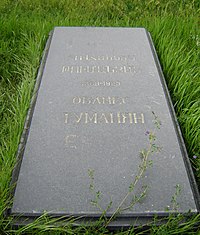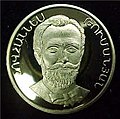Quick Facts
Biography
Hovhannes Tumanyan (Armenian: Հովհաննես Թումանյան, classical spelling: Յովհաննէս Թումանեան) (February 19 [O.S. February 7] 1869 – March 23, 1923) was an Armenian poet, writer, translator, literary and public activist. He is considered the national poet of Armenia.
Tumanyan wrote poems, quatrains, ballads, novels, fables, critical and journalistic articles. His work was mostly written in realistic form, often centering on everyday life of his time. Born in the historical village of Dsegh in the Lori region, at a young age Tumanyan moved to Tiflis, which was the center of Armenian culture under the Russian Empire during the 19th and early 20th centuries. He soon became known to the wide Armenian society for his simple but very poetic works.
Many films and animated films have been adapted from Tumanyan's works. Two operas: Anush (1912) by Armen Tigranian and Almast (1930) by Alexander Spendiaryan, were written based on his works.
Biography




Hovhannes Tumanyan was born on February 19, 1869 in the village of Dsegh, Tiflis Governorate, Russian Empire (now in Lori Province, Armenia).
His father, Aslan (1839–1898), was the village priest known by the name Ter-Tadevos. He was an offspring of an Armenian princely family of Tumanyan, branch of the famous royal house of Mamikonian that settled in Lori in 10th–11th centuries from their original feudal fief of Taron.
His mother, Sona (1842–1936), was an avid storyteller with a particular interest in fables. Young Tumanyan was the oldest of eight children; his siblings were Rostom (1871–1915), Osan (1874–1926), Iskuhi (1878–1943), Vahan (1881–1937), Astghik (1885–1953), Arshavir (1888–1921), Artashes (1892–1916).
From 1877–1879, Tumanyan attended the parochial school of Dsegh. From 1879–1883 he went to a school in Jalaloghly. Tumanyan moved to Tiflis in 1883, where he attended the Nersisyan School from 1883–1887. Tumanyan's wrote his first poem at the age of 12, while studying in Jalaloghly school. He lived at the teacher's house for a while and fell in love with the teacher's daughter Vergine. Since 1893, Tumanyan worked for Aghbyur, Murtch, Hasker and Horizon periodicals and also was engaged in public activism.
In 1899, Tumanyan came up with an idea of organizing meetings of Armenian intellectuals of the time at his house on 44 Bebutov Street in Tiflis (present-day Amaghleba 18, in Sololaki). Soon it became an influential literary group, which often gathered in the garret of Tumanyan's house. Vernatun means garret in Armenian, which was the name the group was referred to. Prominent members of the collective were Avetik Isahakyan, Derenik Demirchyan, Levon Shant, Ghazaros Aghayan, Perch Proshyan, Nikol Aghbalian, Alexander Shirvanzade, Nar-Dos, Vrtanes Papazyan, Vahan Terian, Leo, Stepan Lisitsyan, Mariam Tumanyan, Gevorg Bashinjagyan and many other significant Armenian figures of early 20th century. With some pauses, it existed until 1908.
In 1912 Tumanyan was elected the president of the Company of Caucasus Armenian Writers.
In the fall of 1921, Tumanyan went to Constantinople to find support of Armenian refugees. After months spent there, he returned ill. After surgery in 1922, he started to get better. But in September, Tumanyan's disease started to progress again. He was transferred to a hospital in Moscow, where he died on March 23, 1923.
Personal life
In 1888, at the age of 19, Hovhannes Tumanyan married Olga Matchkalyan, 17. They had 10 children: Musegh (1889–1938), Ashkhen (1891–1968), Nvard (1892–1957), Artavazd (1894–1918), Hamlik (1896–1937), Anush (1898–1927), Arpik (1899–1981), Areg (1900–1939), Seda (1905–1988), Tamar (1907–1989).
Political and public activism
During the government-provoked Armenian–Tatar massacres of 1905–1907, Tumanyan took the role of a peacemaker, for which he was arrested twice. Tumanyan also deeply criticized the Georgian–Armenian War of 1918. Tumanyan was also actively engaged in preaching the Gospel. As he put in one of his verses "There is only one way of salvation; through Jesus Christ abiding inside every one of us".
In October 1914 Tumanyan joined the "Committee for Support of War Victims", which later helped Armenian Genocide refugees settled in Etchmiadzin.
In 1921 in Tiflis he founded the House of Armenian Art.
Literary work
Tumanyan's work is simple, natural and poetically inspired at the same time. It is not by mere chance that dozens of phrases and expressions from Tumanyan's works have become a natural part of people's everyday language, their sayings, adages, and maxims.
Tumanyan is usually regarded in Armenian circles as "All-Armenian poet". He earned this title when the Catholicos of Armenia had ordered that Armenian refugees from the west not enter certain areas of his church and house, since he is considered to be "The Catholicos of all Armenians". Tumanyan in response decried that decision claiming that the refugees could seek relief in the Catholicos' quarters under order of "The Poet of all Armenians".
He created lyrics, fables, epic poems and translations into Armenian of Byron, Goethe and Pushkin.
Tumanyan's most famous works include:
Legacy

Tumanyan's works were translated by Valeri Bryusov, Konstantin Balmont, Joseph Brodsky, Samuil Marshak, Bella Akhmadulina and others.
The following places were named after Tumanyan:

- In Armenia
- Tumanyan's native village of Dsegh was renamed Tumanyan in his honor from 1938–1969.
- In 1951, the village of Dzagidzor of Lori Province was renamed Tumanyan
- Pedagogical University of Vanadzor
- Armenian State Puppet Theater in Yerevan
- Tumanyan St. in central Yerevan
- Tumanyan Park in Yerevan's Ajapnyak district
- Outside of Armenia
- Tumanyan Square (Площадь Туманяна) – in Northern Administrative Okrug of Moscow, Russia.
- Tumanyan Streets in Kiev, Donetsk, Sochi, khutor Shaumyanovsky in Rostov Oblast.
There are 2 museums of Tumanyan in Armenia, one in his birthplace Dsegh and another one in Yerevan. Tumanyan's museum in Yerevan was opened in 1953.
In Autumn of 2011 the government of Armenia purchased Tumanyan's house in Tbilisi from its Georgian owner and its keys are currently kept at the Writers Union of Armenia. The house will presumably be established as a museum.
In popular culture
Opera
- Anush (1912) by Armen Tigranian, based on Anush novel (1902)
- Almast (1930) by Alexander Spendiaryan, based on The Capture of Tmkabert (1902)
The following films were adapted from Hovhannes Tumanyan's works.
Post stamps, banknotes and coins

Soviet post stamp, 1969

Tumanyan memorial coin, 1994

Obverse side of the 5,000 Armenian dram, 1998

Russian post stamp, 2011

Armenian post stamp, 2011





